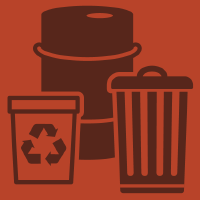Topic Editors


New Research on Waste Treatment, Disposal and Valorization

Topic Information
Dear Colleagues,
Increasingly tighter regulations regarding organic waste and the ever higher demand for renewable chemicals and fuels due to exponential population growth, industrialization and climate change render the management of waste resources to meet global demand more and more challenging. Wastewater, waste plastic, waste food, agricultural waste and carbon dioxide are only a few examples from the field of waste that require effective strategies for their management and valorization to improve cost-effectiveness and meet customers’ demands. The development of environmentally sound, innovative strategies to process waste from different industrial origins is an area of increasing importance in current research. There are two ways to deal with waste generation: the principles and strategies of the circular economy and sustainable development. Much research has been carried out on disposing and decomposing waste as well as on valorization using novel technologies to generate valuable products such as fuels and useful organic chemicals (via biorefinery or white biotechnology). This Topic, titled “New Research on Waste Treatment, Disposal and Valorization", will collect original research papers, reviews and short communications reflecting the state of the art and future applications in this field, with particular emphasis on their application at both laboratory and industrial scales.
Dr. Antonella Angelini
Dr. Carlo Pastore
Topic Editors
Keywords
- waste management
- environment
- biorefinery
- circular economy
- sustainability
Participating Journals
| Journal Name | Impact Factor | CiteScore | Launched Year | First Decision (median) | APC | |
|---|---|---|---|---|---|---|

Catalysts
|
3.8 | 6.8 | 2011 | 13.9 Days | CHF 2200 | Submit |

Energies
|
3.0 | 6.2 | 2008 | 16.8 Days | CHF 2600 | Submit |

Processes
|
2.8 | 5.1 | 2013 | 14.9 Days | CHF 2400 | Submit |

Sustainability
|
3.3 | 6.8 | 2009 | 19.7 Days | CHF 2400 | Submit |

Waste
|
- | - | 2023 | 34.1 Days | CHF 1000 | Submit |

Water
|
3.0 | 5.8 | 2009 | 17.5 Days | CHF 2600 | Submit |

Molecules
|
4.2 | 7.4 | 1996 | 15.1 Days | CHF 2700 | Submit |

Nanomaterials
|
4.4 | 8.5 | 2010 | 14.1 Days | CHF 2400 | Submit |

Preprints.org is a multidisciplinary platform offering a preprint service designed to facilitate the early sharing of your research. It supports and empowers your research journey from the very beginning.
MDPI Topics is collaborating with Preprints.org and has established a direct connection between MDPI journals and the platform. Authors are encouraged to take advantage of this opportunity by posting their preprints at Preprints.org prior to publication:
- Share your research immediately: disseminate your ideas prior to publication and establish priority for your work.
- Safeguard your intellectual contribution: Protect your ideas with a time-stamped preprint that serves as proof of your research timeline.
- Boost visibility and impact: Increase the reach and influence of your research by making it accessible to a global audience.
- Gain early feedback: Receive valuable input and insights from peers before submitting to a journal.
- Ensure broad indexing: Web of Science (Preprint Citation Index), Google Scholar, Crossref, SHARE, PrePubMed, Scilit and Europe PMC.

